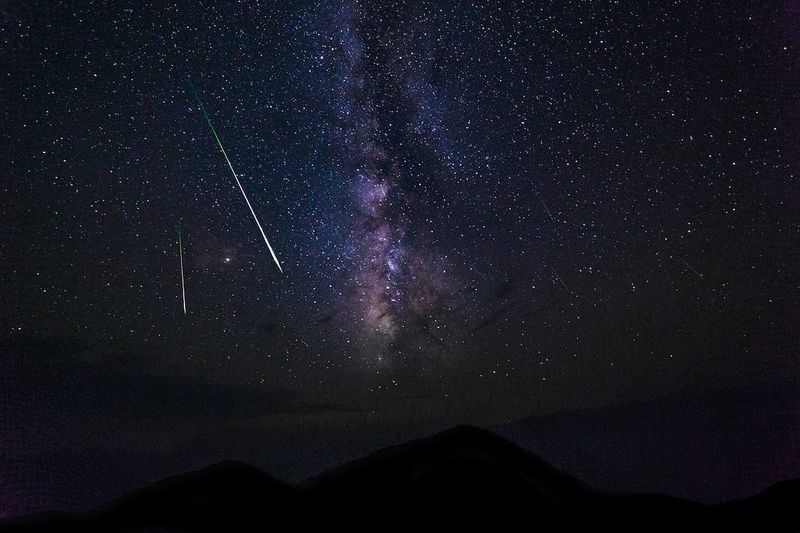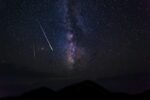**By **
*August 12, 2023*
The night sky has always been a source of wonder and inspiration for humanity. From the earliest civilizations to modern stargazers, we have looked up at the celestial realm in awe and fascination. On certain special occasions, the sky presents us with a breathtaking display, as meteor showers illuminate the darkness with their blazing trails of light. One such event is the Perseids meteor shower, which is set to reach its peak over the weekend, from Saturday, August 12, into Sunday, August 13.
### A Celestial Dance
Meteor showers occur when our planet traverses the debris fields left behind by comets and asteroids during their journey around the sun. As these small particles enter Earth’s atmosphere, they burn up and generate the stunning trails we commonly refer to as shooting stars. The Perseids meteor shower, originating from comet 109P/Swift-Tuttle, is renowned for its annual display of celestial fireworks.
### The Perseids: A Show Not to be Missed
The Perseids meteor shower stands out as one of the most popular and eagerly anticipated meteor showers of the year. Its warm summer nights and high rates of fireballs make it a favorite among skywatchers. The shower is visible only in the Northern Hemisphere, below latitudes 60 degrees north. This year, conditions are particularly ideal, with a slim crescent moon in the sky and a trail of dust left by Swift-Tuttle in 68 B.C., ensuring a potentially spectacular show.
### Skywatching Tips
For those interested in witnessing the Perseids meteor shower, heading to the countryside away from light pollution is recommended. While rural areas afford the luxury of simply stepping outside, city-dwellers need not despair. Many cities have astronomical societies that maintain dedicated dark sky areas, providing urban residents an opportunity to experience the celestial spectacle.
The best viewing times are when the sky is darkest, typically after midnight and before sunrise. To maximize your chances of observing as many meteors as possible, allow your eyes to adjust to the darkness for 30 to 45 minutes upon arrival at your viewing location. Find a comfortable spot, lay back, and take in a vast expanse of the night sky. Clear nights, higher altitudes, and phases of the moon with minimal presence are optimal for meteor observation. Remember, binoculars or telescopes are unnecessary for meteor showers and can restrict your field of view.
### Meteors: A Celestial Symphony
Each meteor shower has its own unique characteristics and peaks on a specific date when Earth plows through the densest part of the debris field. However, meteors can still be visible before and after the peak night. Shower names are derived from the constellation they appear to radiate from, though meteors can be observed all over the sky during any given shower.
### Final Thoughts: Embracing the Majestic
The Perseids meteor shower presents an opportunity for us to reconnect with the wonders of the natural world and marvel at the grandeur of the universe. It is a reminder of the vastness beyond our terrestrial existence and the intricate dance of celestial bodies that shape our cosmos. As we witness the celestial spectacle this weekend, let us reflect on our place in the universe and the beauty that lies beyond the confines of our daily lives.
So take a moment, venture outside, and immerse yourself in the majesty of the Perseids meteor shower. Let its ethereal light guide your thoughts, and may it ignite a spark of curiosity and awe that will continue to ignite our thirst for knowledge about the cosmos.

<< photo by Austin Human >>
The image is for illustrative purposes only and does not depict the actual situation.
You might want to read !
- Finding Perseid Meteor Splendor: When and Where to Witness the 2023 Celestial Spectacle
- Your Guide to Celestial Spectacles: Full Moons, Supermoons, Blue Moons, and the Meteor Shower Extravaganza
- “Why is the strawberry moon named so, and what makes it special?”
- “What is the significance of the strawberry moon and why is it called that?”
- Why the Strawberry Moon is a rare celestial event to behold
- “Supermoon Spectacle: A Celestial Delight Amplified by Rocket Launch”
- “Unveiling the Majestic Supermoon: August’s Full Sturgeon Moon Illuminates the Skies”
- The Astronomical Significance of the Next Supermoon: The Sturgeon Moon Rises




